Serviços Personalizados
Journal
Artigo
Indicadores
Links relacionados
Compartilhar
Finisterra - Revista Portuguesa de Geografia
versão impressa ISSN 0430-5027
Finisterra no.98 Lisboa dez. 2014
ARTIGO ORIGINAL
Adaptation strain index for tourists traveling from central and northern Europe to the Mediterranean
Índice de adaptação climática em turistas viajando do centro e do norte da europa para o Mediterrâneo.
Krzysztof Blazejczyk1 Vera Vinogradova2
1 Institute of Geography and Spatial Organization, Polish academy of sciences. Twarda 51/55, 00-818 Warszawa, Poland. E-mail: k.blaz@twarda.pan.pl
2 Institute of Geography, Russian academy of Sciences, 119017, Staromonetniy Pereulok 29, Moscow, Russia. E-mail: vvvinog@yandex.ru
ABSTRACT
One of the principal features of climate is its spatial variability. Long distance travels are an essential part of life in contemporary societies. In 2012 tourism arrivals reached 1 billion people at the global scale. In a short time one can move to extremely different climatic conditions and ones organism is under great pressure of atmospheric stimuli which can be very different from those experienced at home. Spatial differences in climate stimuli need various adaptation strategies in humans. The paper considers adaptation strain in tourists from seven central and northern European cities travelling to the Mediterranean regions of Barcelona, Rome and Athens for the period 1991-2000. The adaptation strain index (ASI) was applied for this purpose. Seasonal and spatial patterns of bioclimatic contrasts are considered. Summer was the season with greatest spatially differentiated adaptation strain, but in winter the need for adaptation was the highest.
Keywords: Bioclimate, adaptation strain index (ASI), tourism, Europe, Mediterranean.
RESUMO
Uma das principais características do clima é a sua variabilidade espacial. As viagens de longo curso, para turismo de lazer ou de trabalho, são uma característica da sociedade contemporânea. Em 2012, as chegadas atingiram mil milhões a nível mundial. Num curto espaço de tempo, o organismo humano pode ficar submetido a condiçõ es climáticas muito diversas das habituais, o que exige diversas estratégias de adaptação. Estuda-se, neste artigo, a tensão a que ficam sujeitos os turistas que se deslocam de sete locais da europa Central e do norte em direcção a três cidades no Mediterrâ neos: Atenas, Barcelona e Roma, no período 1999-2000. Utiliza-se, para este propósito, o Adaptation Strain Index (ASI). Na an álise, consideram-se contrastes estacionais e espaciais. O Verão é a estação com maiores contrastes de ASI, mas no inverno é necessária uma maior adaptação para os turistas que chegam ao Mediterrâneo.
Palavras-chave: Bioclima, Adaptation Strain Index (ASI), turismo, europa, Mediterrâneo.
RÉSUMÉ
Indice dadaptation climatique pour les touristes du centre et du nord de lEurope voyageant en régions Méditerranéennes. Le climat est marqué par une forte variabilit é spatiale. Or les voyages à longue distance, pour le tourisme ou pour les affaires, sont un trait essentiel de la vie contemporaine ; en 2012, on a enregistré un total mondial dun milliard d « arrivées ». Lorganisme est donc soumis, en très peu de temps, à des conditions climatiques fort différentes de celles auxquelles il est habitué, ce qui exige de recourir à diverses strat égies dadaptation. On étudie ici celles qui concernent la tension affectant les touristes de sept villes du Centre et du nord de l Europe voyageant en régions méditerranéennes (Athènes, Barcelone et Rome) pour la période 1991-2000. LAdaptation Strain Index (ASI) est utilisé, en considérant divers cas de contrastes bioclimatiques saisonniers et spatiaux. Les plus grands contrastes ont lieu en été, mais cest en hiver que les touristes qui arrivent en Méditerranée doivent sadapter le plus.
Mots-clés: Bioclimat, Adaptation Strain Index (ASI), tourisme, Europe, Méditerranée.
I. INTRODUCTION
During the last decades tourism activity has increased all over the world. according to the United nation World tourism Organization, international arrivals have increased from 436 million in 1990 to 1095 million in 2012 (UNWTO tourism Highlights, 2013). The most frequently visited places are European countries (534 million in 2012). The Mediterranean region was visited by 191 million tourists arriving by aircraft and was the most popular arrivals destination not only in Europe but also in the entire world (fig. 1).
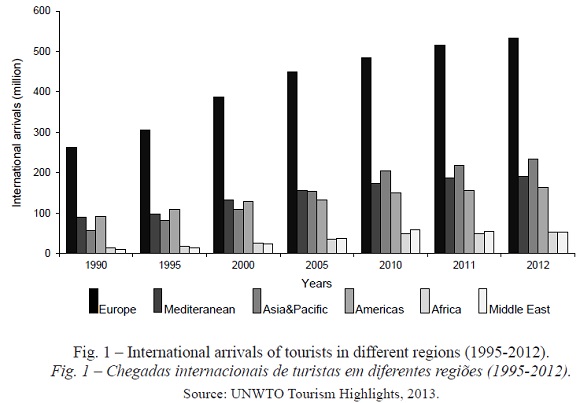
For people travelling long distances, information about climate contrasts they are likely to experience is very important. Their organisms must adapt to new climate stimuli especially in Europe, where seasonal and spatial variability is one of the essential features of climate and seasonal changes of weather that can be far reaching.
In general, increase in differences of climate intensifies the magnitude of adaptation processes in an organism (Koppe and Jendritzky 2005; Jendritzky and de Dear 2008). Several research studies discuss adaptation strategies of the human organism to varied atmospheric stimuli (Givoni and Goldman 1973; le Blanc 1975; Clark and e Dholm 1985; Kenney 1985; Parsons 2003). Special attention is given to physiological costs to keep homeothermy, i.e. constant core temperature (about 37ºC) in different thermal environments. Various important adaptation processes take place when the individual is faced with a wide range of ambient temperatures (Br öde et al., 2012, table I).
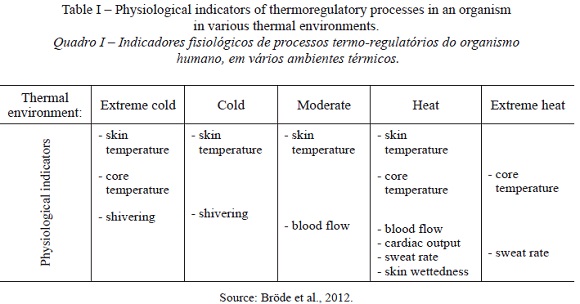
In cold environments, all physiological efforts of an organism lead to minimising heat loss from the body. The centre of thermoregulation reduces skin blood flow which results in decreASIng skin temperature and increasing thermoinsulative properties of the skin (le Blanc 1975; Clark and Edholm, 1985). Additionally, muscles produce heat by shivering thermogenesis (fiala et al., 1999, 2001). The autonomic mechanisms of temperature regulation are usually supported by behavioural thermoregulation, mostly by well insulated clothing (Holmé r 1988; isO/Dis 11079).
In hot conditions physiological processes lead to an intensification of the expenditure of heat from the body. The most important is an increase of skin blood flow. This then results in the activation of sweat glands and in intensification of cardiac output (Beaumont and Bullard, 1965; Garden et al., 1966; Elizondo and Bullard, 1971; Givoni and Goldman, 1973). Evaporation of sweat reduces risk of body overheating (Kenney, 1985). However, it also leads to disturbances in water and mineral balances of an organism (Blazejczyk and Szygula, 2004).
While our knowledge of the mechanisms of thermal adaptation is relatively good (Hensel, 1981; Clark and Edholm, 1985), there are, however, only few attempts to quantify assessments of bioclimatic contrasts between different sites. One of the first is the concept of Bioclimatic Distance (BD) index proposed by Mateeva and Filipov (2003). The index is based on the comparison of effective clothing insulation index (ECI). It represents thermal insulation of clothing necessary for keeping the balance between heat gains and losses in the human body. ECI is calculated by solving human heat balance model MeneX_2005 (BioKlima 2.6.) at constant skin temperature of 32ºC and metabolic heat production of 135 W·m-2. The BD index is calculated as follows (eq. 1):

where: ECIh – effective clothing insulation at the home location (in clo units), ECId – effective clothing insulation at the destination (in clo). The numerical coefficient 13 is expressed in clo and it represents maximal difference in ECI. The authors successfully applied BD index for assessing bioclimatic differentiation of the Balkan Peninsula using mean monthly meteorological data.
Two authors, de Freitas and Grigorieva (2009) have proposed acclimatisation thermal strain index ( ATSI) based on the Rusanov (1989) concept of heat loss by respiration. Differences in respiratory heat loss were used to assess bioclimatic contrasts in Siberia. ATSI considers heat loss by respiration at the home location (Resh) and at the studied destination (Resd) and is calculated as follows (eq. 2):

Blazejczyk (2011) has proposed the Bioclimatic Contrast Index (BCI) which consists of four parameters which are used for validation of bioclimatic conditions: Water Loss (SW) – as adaptation measure in hot environments, insulation Predicted (Iclp) – as adaptation measure in cold conditions, Physiological subjective temperature (PST) – as a measure of thermal sensations and Universal thermal Climate index (UTCI) – as an indicator of heat stress (eq. 3).

where dUTCI, dPST, dSW and dIclp are differences of particular biothermal indices in compared sites.
BCI was applied to evaluate the spatial variability of bioclimate in Poland.
Each of the previously developed indices has advantages and weaknesses, which are discussed by Blazejczyk (2011). While BD and ATSI are mostly appropriate for cold climates, BCI can be used in a wide range of environmental conditions. However, as BCI was applied to non-normalized values of partial indices and in specific weather situations, it has unrealistic values.
The aim of the present research is to discuss the adaptation strain which tourists from central and northern European cities can be subject to when travelling by plane to the Mediterranean region. Seasonal patterns of regional differences are discussed and validated. Taking into consideration limitations of other indices the adaptation strain index (ASI) is used for this purpose.
II. METHODS AND MATERIALS
As shown in table I, every thermal environment triggers specific physiological reactions. Several physiological and behavioural reactions are crucial for the adaptation to new thermal conditions. In the present research, the direction and the intensity of these reactions are assessed by the adaptation strain index ( ASI). The index includes three measures of adaptation processes of an organism to different ambient conditions. (i) the water loss index (SW, g ·hour-1) is a measure of active adaptation to hot conditions by altering sweating and evaporation of sweat from the skin (Blaz ejczyk, 2007). (ii) The Insulation Predicted index (Iclp, clo) is a practical measure of adaptation to cold through changes of insulative properties of clothing (Burton and Edholm, 1955; Fourt and Hollies, 1970; Havenith et al., 2012). (iii) the Universal thermal Climate index (UTCI, ºC) is a complex measure of physiological responses to actual ambient conditions by activation of different adaptation processes listed in table I (Blaz ejczyk et al., 2010; Bröde et al., 2012).
The calculation of ASI includes several steps.
1) The values of partial indices (SW, Iclpi, and UTCI) are calculated based on daily meteorological data. In the present research, the data of air temperature, air vapour pressure, wind speed and total cloud cover for 12 UtC were used. The midday meteorological observations of air temperature, vapour pressure, wind speed and total cloud cover were used because of their representativeness to day-time period of the most intensive tourism outdoor activity. The data cover the period 1991-2000. The meteorological stations of Barcelona, Rome and Athens represent the Mediterranean region and the seven stations of Paris, Dublin, Budapest, Warsaw, Moscow, Helsinki and Murmansk represent parts of central and northern Europe (fig. 2)ii. Most of meteorological data used in the research were obtained from national meteorological services via European Commission PHEWE project. Only data for Moscow and Murmansk were obtained from Russian Meteorological service. The partial indices were calculated with the use of BioKlima 2.6 software package (http://www.igipz.pan.pl/Bioklima-zgik.html).
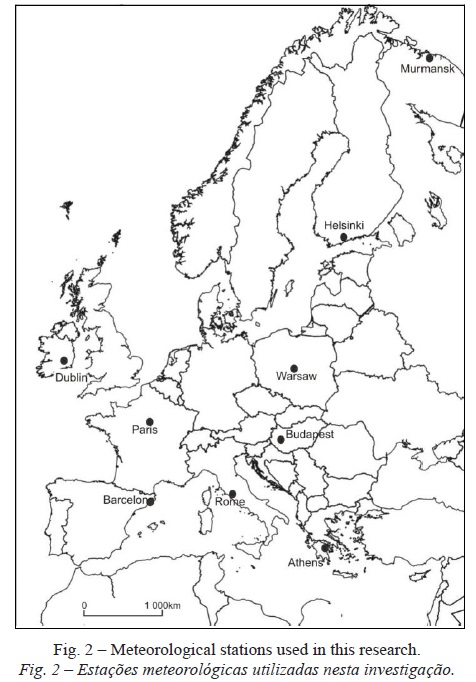
2) As the partial indices applied in ASI represent different units and various ranges of values, the second step was to normalize them to the range from 0 to 1. The following equations were used in this purpose (eq. 4; eq. 5 and eq. 6):



3) The differences of partial indices between home locations and tourism destination sites were calculated for each day of the studied period. The calculations start from analysis of UTCI values. if UTCI in both sites: home (marked by h) and destination (marked by d) are within the range of no thermal stress (i.e. between 9ºC and 26ºC) then dUTCI n is taken as 0, i.e. differences in heat stress are very slight and adaptation strain does not occur. In another cases dUTCI n is calculated as follows (eq. 7):

Adaptation strain related to differences in water loss due to sweating is assessed as follows (eq. 8):

However, adaptation strain caused by the changes in predicted clothing insulation is calculated with the following equation (eq. 9):

4) As mentioned above, different adaptation reactions are specific to particular ranges of ambient conditions (table I). The need to adapt to cold environments is indicated by d UTCI n below 0. In case of adaptation to heat conditions the dUTCI n is above 0. Adaptation strain to cold is assessed by both the differences in UTCI and Iclp between compared sites. The ASI equation has the following mathematical form (eq. 10):

Adaptation strain to heat is a function of differences in Universal thermal Climate index (UTCI) and water loss due to sweating (SW ). In this case ASI is calculated as follows (eq. 11):

Positive values of ASI indicate warmer and negative ASI illustrates cooler conditions at the chosen destination than at the home location. The values of adaptation strain index can be categorized in 11 classes, one neutral, five referring to adaptation strain to heat and five representing adaptation strain to cold (table II). Each strain category has specific biothermal criteria.
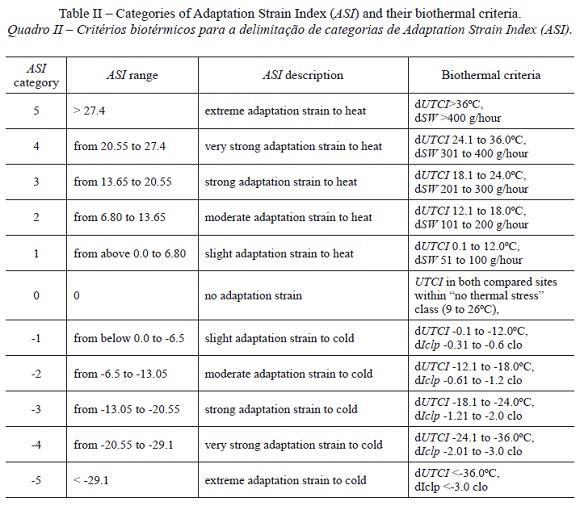
The adaptation strain index was calculated for each day of the studied period (1991-2000) and for every pair of compared stations. Mean ASI values and frequencies of its particular categories were used as characteristics for monthly periods and for seasons.
III. RESULTS
1. General adaptation strain levels
The analysis of mean ASI values in particular seasons show that the greatest intensities of adaptation strain occur in the summer months (fig. 3b). When travelling to Athens the tourists from each studied central/northern European cities can experience, on average, at least a strong adaptation strain to heat (for the citizens of Murmansk the average ASI values go up to very strong heat stress category, ASI=4, table II and fig. 3b). Travelling to Rome and Barcelona in summer is less oppressive for tourists from central and northern Europe than visiting Athens. Taking Murmansk as a starting point, the mean ASI values are within category 1, of slight adaptation strain to heat (table II). Travelling to Athens in spring and autumn is more stressful than visiting Rome and Barcelona (fig. 3a and c). However, mean seasonal ASI values for arrivals in each Mediterranean city are mostly within category 1– slight adaptation strain to heat (ASI range from 0 to 6.8, table II). Only citizens from northern cities (Helsinki, Murmansk) will experience moderate intensity of adaptation to heat (category 2, ASI=6.8 to 13.65, table II). In winter months (fig. 3d), travelling to Mediterranean cities can lead to slight (for citizens of Dublin and Budapest), moderate (for citizens of Paris, Warsaw, Moscow and Helsinki) or to strong (in case of visitors from Murmansk) adaptation strain to hot conditions (fig. 3).
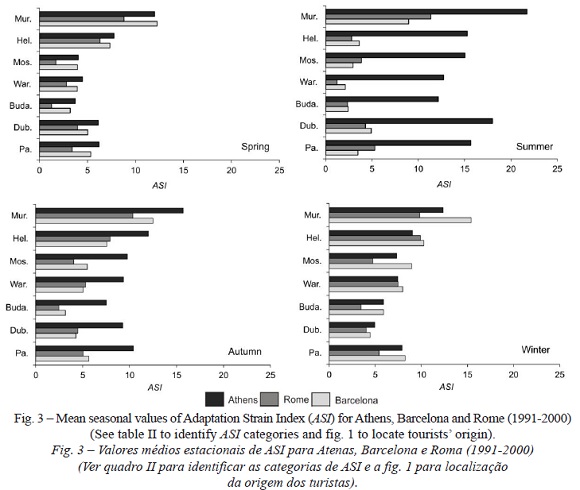
The general information about mean adaptation strain levels are insufficient for a better understanding of the climatic risk related to a sudden change of thermal environment. We should also know the possible range of adaptation strain and the frequencies of ASI categories which occur at particular destinations in Europe.
When planning tourist visits we consider several factors, e.g. attractiveness, price, transportation facilities, possible weather. For many tourists weather plays a very important role in the choice of destination and time of the year for their holidays. Many of us search for climates which differ from our domestic conditions, being warmer or cooler than the climate we are living in. While young healthy people can adapt fairly easily to sudden changes of climate/weather conditions, for children, elderly and unhealthy people adaptation to new ambient conditions can be very stressful, especially for the circulatory system. Thus, for these groups of people, we must consider in detail which adaptation strain their organisms can be exposed to.
2. Spring
In spring months (March to May) travelling from the majority of the origin locations to Mediterranean destinations leads most frequently to slight or moderate adaptation strain (ASI categories 1 and 2). The no adaptation strain category is relatively frequent. This situation occurs during 13-20% of days when travelling from Dublin, Paris and Helsinki and during 26-34% of days in case of Warsaw, Budapest and Moscow. It is surprising that for some pairs of stations (Moscow-Athens, Moscow-Barcelona and Warsaw-Rome) no thermal strain category is the most frequent. To explain this phenomenon more detailed research is needed. Spring travels to Mediterranean region from most northerly located sites in Europe (e.g. Murmansk) lead to moderate (43.3% of days in case of Barcelona and 60.5% of days in case of Rome) or strong (up to 43.1% of days in case of traveling to Barcelona) adaptation strain to hot conditions. Considering ASI values we can also find that there are not substantial differences in adaptation strain when comparing particular Mediterranean destinations (table III a, b and c). It is also interesting that thermal conditions in Mediterranean cities in spring are sometimes cooler than in some of the studied origin locations. for example in Rome, citizens of Warsaw and Budapest can experience slight and moderate adaptation strain to cold during about 20% and 17% of spring days, respectively (figures in bold on table III b). The smallest frequency of such reverse thermal situations is observed in the case of Barcelona (table III d).
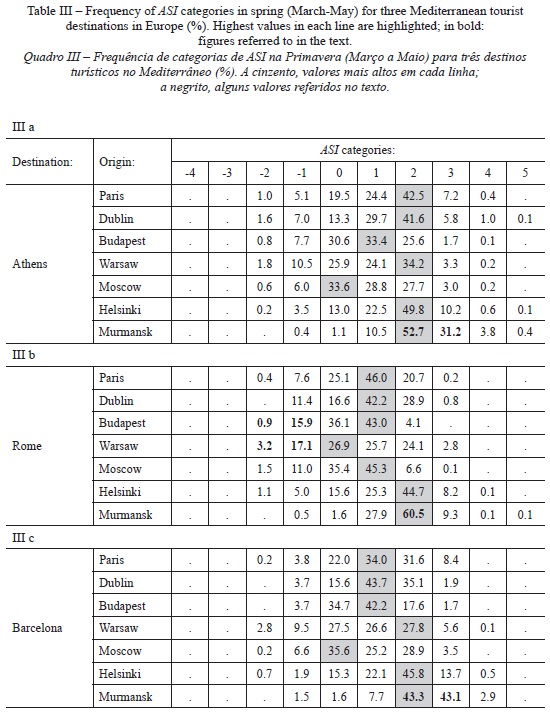
3. Summer
Summer is the season with the most differentiated adaptation strain. The strongest adaptation is needed when travelling to Athens. For most of the origin locations, moderate (ASI category 2) and strong (category 3) adaptation strain to heat occurs in more than 60% of days (table IV). Murmansk citizens can experience strong (ASI category 3) and very strong (category 4) heat adaptation in 70.2% of summer days (table IV a, bold figures). Moreover, during about 20% of days they can suffer even extreme adaptation strain to heat (ASI =5). Comparing thermal conditions found in Rome and Barcelona by northern and Central European tourists (except from Murmansk) we find that they do not differ so significantly as in Athens. While in Athens no thermal strain category is very rare, in the other locations it is very frequent. a great number of summer days in Barcelona and Rome (28-44%) are characterized by very similar thermal conditions (to other stations, except Murmansk) and adaptation is not needed (category 0). 16-19% of summer days in Warsaw, Budapest and Moscow can be warmer than in Rome (categories -1 and -2) and adaptation to cold is needed. However, in 40-49% of the days travellers from these cities to Rome can experience slight (category 1) and moderate (category 2) adaptation strain to heat. For all other Mediterranean locations citizens from central and northern cities can experience slight to very strong adaptation to heat in 30-70% of the days (table IV).
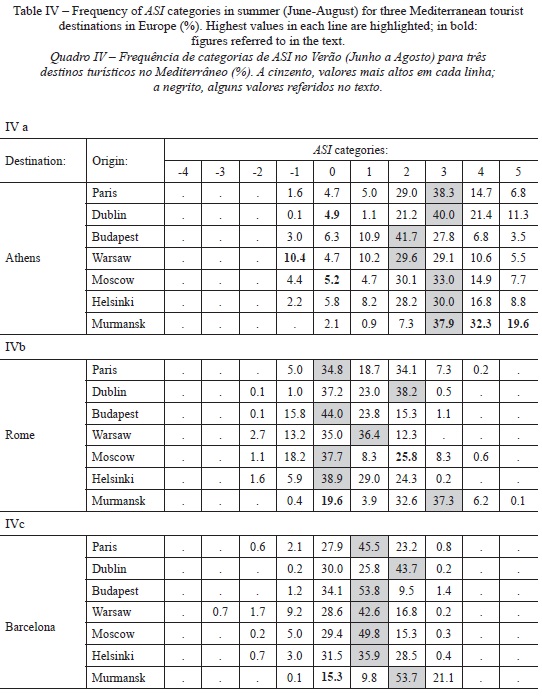
4. Autumn
In autumn months (September-November) moderate adaptation to heat was the most frequently found ASI category (table II and table V a). When travelling to Athens tourists must be prepared to meet this thermal contrast in 45-50% of days. For visitors from Murmansk the adaptation strain is even greater: about 97% of days are characterized by at least moderate adaptation strain to heat (56.4% of days with strong adaptation strain). Thermal differences between studied origin locations and Barcelona are similar to those observed for Athens. Only travellers from Dublin and Budapest can expect a little milder condition (40-42% of days with slight adaptation strain, category 1) when traveling to Barcelona. In autumn, Rome is the most favourable Mediterranean city for tourists from central Europe: 22.8-41.5% of days are characterised by no adaptation strain ASI category. Days with slight adaptation to heat are also very frequent (21.2-46%). However, travellers from northern Scandinavia to Rome can experience very frequently moderate (55.8-69%) or strong (12.5-15.2%) adaptation strain to hot conditions (table V b).
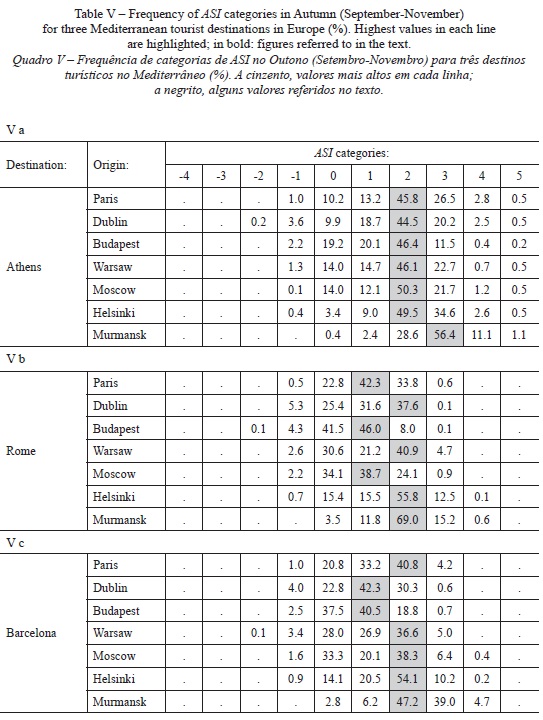
5. Winter
Winter is the season with the highest temperature differences between Mediterranean and other parts of Europe. As a result neutral adaptation conditions (no adaptation strain) occur only occasionally. For all destinations slight or moderate adaptation strain to hot conditions (categories 1 and 2) can be experienced by the visitors from central European cities in the majority of days (80-98%). The travellers from northern origins (Murmansk) can suffer strong adaptation strain (category 3) during 10% of days in Rome and 40-48% of days in Athens and Barcelona. a significant frequency of ASI category 3 (12-17%) is also observed in case of Barcelona when travelling there from Paris, Warsaw and Moscow (table VI).
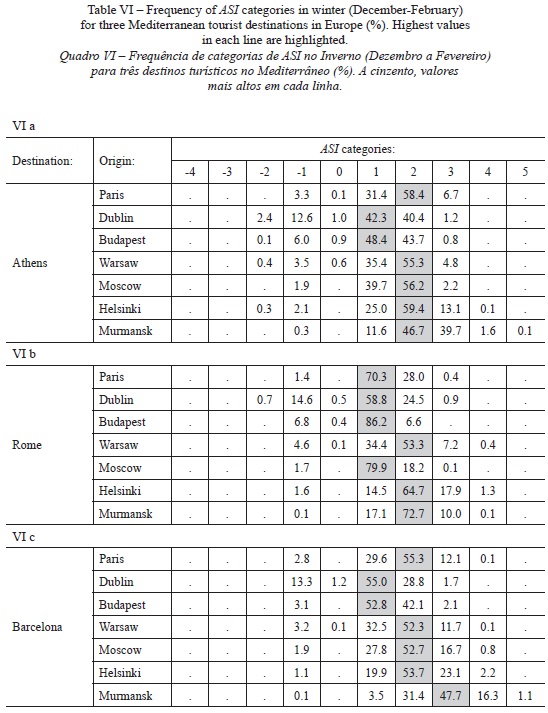
IV. DISCUSSION AND CONCLUSIONS
To our knowledge no in-depth comparative studies of bioclimatic contrasts in Europe have been published. However, research by Matzarakis and Mayer (1991, 1997) indicate severe, hot bioclimatic conditions during the summer season in Athens. The authors ascertain that extreme hot conditions in summer months in the eastern part of Mediterranean can be stressful for populations from Central and northern Europe. The high heat load of the Athens climate was also reported by Blazejczyk and Szygula (2004) when assessing bioclimatic conditions during the 2004 athens Olympic Games.
Also, the Jendritzkys maps (personal communication) which display the frequency distribution of various heat/cold stress categories over Europe, show the peculiarity of Mediterranean bioclimate. This is demonstrated by the frequent occurrence of heat stress. For other locations the frequencies of extreme heat/cold stress were similar to each other.
Blazejczyk and Kunert (2010) have found significant regional differences of European climate in summer and winter seasons. When analysing the frequencies of particular ranges of Universal thermal Climate index (UTCI) they have noted the predominance of extreme heat stress in summer in the whole Mediterranean region. On the other hand, high cold stress was very frequently observed in Central Europe and in the Scandinavian region.
The present research confirms the results obtained by Matzarakis and Mayer (1991, 1997), Blazejczyk and Szygula (2004), Nastos and Matzarakis (2013), Cohen et al. (2013) as well as Bleta et al. (2013). The authors studied bioclimatic conditions in various parts of Greece. They confirm the occurrence of high heat stress during summer months. Such stress is a limiting factor for active recreation and tourism activity. Similarly, loaded thermal conditions in summer were also reported for Lisbon by Oliveira and Andrade (2007).
Lindner-Cendrowska (2013a, 2013b) compared thermal conditions in three European cities: Madrid, Warsaw and Stockholm. She has found that the summer months in Madrid can be unfavourable for physical activity, especially for foreign tourists. However, she also reported that in Warsaw tourists can meet stressing thermal conditions in summer, mainly in July.
The results of the present research show that the adaptation strain index (ASI) is a useful measure of bioclimatic contrasts between different locations. ASI provides practical recommendations regarding direction and intensity of adaptation processes in human organism.
When travelling to Mediterranean destinations the residents of central and northern Europe must remember to pack appropriated clothing, usually lighter than used at home. However, in spring and in autumn, thermal conditions in Mediterranean cities are some-times cooler (15-20% of days) than in the studied origin locations and tourists should also have warm clothing. Summer is the season when strong adaptation strain is experienced. Visitors must remember not only to wear light clothing but also to drink enough water to protect themselves against dehydration (the strongest dehydration risk occurs in eastern part of Mediterranean). Winter is the season with relatively mild thermal condition in southern Europe. However, in central and northern parts of the continent thermal conditions are rather severe and differ greatly with the Mediterranean climate. It causes slight or moderate adaptation strain to heat and the adaptation time can be longer (up to 5-6 days) than in other seasons.
ACKNOWLEDGEMENTS
The study was carried out in the frame of research co-operation between institute of Geography and spatial Organization, Polish academy of sciences and institute of Geography, Russian academy of sciences within the project assessment of the potential of European bioclimate for recreation and tourism. Part of the data was obtained through the EU PHEWE project assessment and Prevention of acute Health effects of Weather Conditions in Europe (QLK4-Ct-2001-00152).
BIBLIOGRAPHY
Beaumont van W, Bullard RW (1965) Sweating: Direct influence of skin temperature. Science, 147(3664): 1465-1467. [ Links ]
BioKlima 2.6, software package, http://www.igipz.pan.pl/geoekoklimat/blaz/bioklima.htm
Blancle J (1975) Man in the cold. ChC Thomas Publ, Springfield. [ Links ]
Blazejczyk K (2011) Assessment of regional bioclimatic contrasts in Poland. Miscellanea Geographica, 15: 77-91.
Blazejczyk K (2007) Multiannual and seasonal weather fluctuations and tourism in Poland. In Amelung B, Blazejczyk K, Matzarakis A (eds.) Climate Change and Tourism Assessment and Copying Strategies, Maastricht–Warsaw–Freiburg: 69-90.
Blazejczyk K, Broede P, Fiala D, Havenith G, Holmér I, Jendritzky G, Kampmann B, Kunert A (2010) Principles of the new Universal Thermal Climate Index (UTCI) and its application to bioclimatic research in European scale. Miscelanea Geographica, 14: 91-102.
Blazejczyk K, Kunert A (2010) Warunki bioklimatyczne wybranych aglomeracji Europy i Polski [Bioclimatic conditions of selected agglomerations in Europe and in Poland]. In Bednorz E, Kolendowicz L (eds.) Klimat Polski na tle klimatu Europy, Zmiany i konsekwencje. Bogucki Wyd. Naukowe, Poznan: 93-106.
Blazejczyk K, Szygula Z (2004) http://www.igipz.pan.pl/geoekoklimat/blaz/blaz12.pdf (The influence of hot environment on physical effectiveness at competitors of Olympic Games in Athens). Sport Wyczynowy, 42(5/6):45-63.
Bleta A, Nastos PT, Matzarakis A (2013) Assessment of bioclimatic conditions on Crete Island, Greece. Reg Environ Change, DOI 10.1007/s10113-013-0530-7
Bröde P, Fiala D, Blazejczyk K, Holmér I, Jendritzky G, Kampmann B, Tinz B, Havenith G (2012) Deriving the Operational Procedure for the Universal Thermal Climate Index UTCI. Int J Biometeorol, 56: 481-494. [ Links ]
Burton AC, Edholm OG (1955) Man in a cold environment. E. Arnold Publ., London. [ Links ]
Clark RP, Edholm OG (1985) Man and his thermal environment. E. Arnold Ltd., London.
Cohen P, Potchter O, Matzarakis A (2013) Human thermal perception of Coastal Mediterranean outdoor urban environments. [ Links ] Applied Geography 37: 1-10.
Elizondo RS, Bullard RW (1971) Local determination of sweating and the assessment of the "Set point".Int J Biometeorol, 15(2-4): 273-280. [ Links ]
Fiala D, Lomas KJ, Stohrer M (2001) Computer prediction of human thermoregulatory and temperature responses to a wide range of environmental conditions. Int J Biometeorol, 45: 143-159. [ Links ]
Fiala D, Lomas KJ, Stohrer M (1999) A computer model of human thermoregulation for a wide range of environmental conditions: The passive system. J Appl Physiol, 87(5): 1957-1972. [ Links ]
Fourt J, Hollies NRS (1970) Clothing. Comfort and function. M. Dekker Inc., New York. [ Links ]
de Freitas CR, Grigorieva EA (2009) The Acclimatization Thermal Strain Index (ATSI): a preliminary study of the methodology applied to climatic conditions of the Russian Far East. Int J Biometeorol, 53: 307-315. [ Links ]
Garden JW, Wilson ID, Rasch PJ (1966) Acclimatization of healthy young adult males to a hot-wet environment. J Appl Physiol, 21(2): 665-669. [ Links ]
Givoni B, Goldman RF (1973) Predicting effects of heat acclimatization on heart rate and rectal temperature. J Appl Physiol, 35(6): 875-879. [ Links ]
Havenith G, Fiala D, Blazejczyk K, Richards M, Bröde P, Holmer I, Rintamaki H, Benshabat Y, Jendritzky G (2012) The UTCI-Clothing Model. Int J Biometeorol, 56: 461-470. [ Links ]
Hensel H (1981) Thermoreception and temperature regulation. Academic Press, London. [ Links ]
Holmér I (1988) Assessment of cold stress in terms of required clothing insulation - IREQ. Int. J Industrial Ergonomics, 3:159-166. [ Links ]
ISO/DIS 11079, Evaluation of cold environments. Determination of required clothing insulation. International Organisation of Standardization, Geneva. [ Links ]
Jendritzky G, de Dear R (2008) Adaptation and the Thermal Environment. In Ebi KL, Burton I, McGregor G (eds.) Biometeorology for Adaptation to Climate Variability and Change: Research Frontiers and Perspectives. Springer, Heidelberg: 9-32. [ Links ]
Kenney WL (1985) A review of comparative responses of men and women to heat stress. Environ Res., 37(1): 1-11. [ Links ]
Koppe C, Jendritzky G (2005) Inclusion of short-term adaptation to thermal stresses in a heat load warning procedure. Meteorol Zeit, 14(2): 271-278. [ Links ]
Lindner-Cendrowska K (2013a) Assessment of bioclimatic conditions in cities for tourism and recreational purposes (a Warsaw case study), Geographia Polonica, 86(1): 55-66. [ Links ]
Lindner-Cendrowska K (2013b) Evaluation of bioclimatic conditions for tourism and recreation in selected European cities. PhD thesis (in Polish), University of Warsaw, Faculty of Geography and Regional studies. [ Links ]
Mateeva Z, Filipov A (2003) Bioclimatic distance index in the Rila-and-Rhodopy area of Bulgaria. In Blazejczyk K, Krawczyk B, Kuchcik M (eds.) Postepy w badaniach klimatycznych i bioklimatycznych. Prace Geograficzne IGiPZ PAN, 188: 295-302.
Matzarakis A, Mayer H (1997) Heat stress in Greece. Int J Biometeorol, 41:34-39. [ Links ]
Matzarakis A, Mayer H (1991) The extreme heat wave in Athens in July 1987 from the point of view of Human Biometeorology. Atm Environ, 25B: 203-211. [ Links ]
Nastos P, Matzarakis A (2013) Human Bioclimatic Conditions, Trends, and Variability in the Athens University Campus, Greece. Human Bioclimatic Conditions, Trends, and Variability in the Athens University Campus, Greece. Advances in Meteorology, Vol. 2013, Article ID 976510, 8 pages, http://dx.doi.org/10.1155/2013/976510 . Hindawi Publishing Corporation.
Oliveira S, Andrade H (2007) An initial assessment of the bioclimatic comfort in an outdoor public space in Lisbon. Int J Biometeorol, 52: 69-84. [ Links ]
Parsons KC (2003) Human thermal environments: the effects of hot, moderate, and cold environments on human health, comfort and performance. Taylor & Francis, London, New York. [ Links ]
Rusanov V (1989) Appraisal of Meteorological Conditions defining Human Respiration. Bull. Rus. Academy of Medical Scien., 1: 7-60. [ Links ]
UNWTO Tourism Highlights (2013) Edition, available at http://mkt.unwto.org/publication/unwto-tourism-highlights-2013-edition (Feb. 16, 2014)
Received: January 2014. Accepted: June 2014.
NOTES
i Iclp index is mostly dedicated to cold conditions. thus, because of its mathematical formulation in warm and hot environments Iclp can be below 0. Before applying Iclp their values lower than 0.3 clo must be assumed as 0.3 clo (0.3 clo refers to very light beach clothing).
iithe authors intended to use the widest representation of stations in Europe. However, they had only the listed stations at their disposal. some stations (as e.g. London) were excluded from comparisons because of incompleteness of daily meteorological data.














